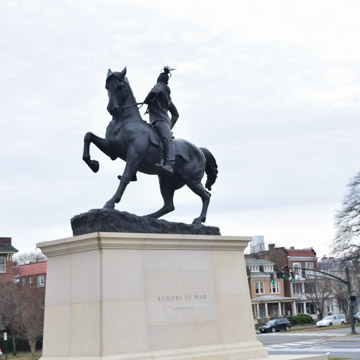Kehinde Wiley’s 27-foot-tall, 60,000-pound bronze equestrian statue confronts the legacy of slavery and the glorification of the Confederacy. The statue depicts a young African American man astride a rearing horse. The rider wears his dreadlocks in a high ponytail and is dressed in a hoodie, ripped jeans, and Nike high-tops. The statue rests on a large stone podium in a small plaza in front of the Virginia Museum of Fine Arts. Its rider turns in his saddle away from the United Daughters of the Confederacy National Headquarters, directly in front of it to the north.
The statue is located a few blocks south of Monument Avenue, which was lined with Confederate war monuments from the early twentieth century until July 2020, when the police killing of George Floyd reignited efforts to remove these symbols of white supremacy from public spaces. One of those monuments, Frederick Moynihan’s equestrian statue of Confederate Army General James Ewell Brown “J.E.B.” Stuart (1907), inspired the composition of Wiley’s Rumors of War.
Rumors of War, Wiley’s first monumental public sculpture, was first displayed in Times Square in New York City in September 2019. Purchased by the Virginia Museum of Fine Arts, the statue was moved to Richmond and unveiled to great ceremony on December 10, 2019. Wiley, an acclaimed artist, known for such paintings as the official portrait of President Barack Obama, views the statue as a corrective to the images of history portrayed nearby. He believes building new monuments is a way to “compose poetry of broken bones.” Indeed, Rumors of War is a potent symbol that repositions young Black men within the public consciousness, confronting both the controversial monuments and the structural racism they embody.
References
Capps, Kriston. “Kehinde Wiley’s Anti-Confederate Memorial.” The New Yorker, December 24, 2019.
“Rumors of War.” Times Square Arts. Accessed July 22, 2020. http://arts.timessquarenyc.org/.
“Rumors of War.” Virginia Museum of Fine Arts. Accessed July 22, 2020. https://www.vmfa.museum/.

